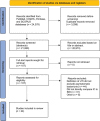Is It Really the Foley? A Systematic Review of Bladder Management and Infection Risk
- PMID: 36819923
- PMCID: PMC9936901
- DOI: 10.46292/sci22-00009
Is It Really the Foley? A Systematic Review of Bladder Management and Infection Risk
Abstract
Background: The belief that intermittent catheterization results in fewer infections than indwelling catheters is commonly expressed in the spinal cord injury literature. Some practice guidelines strongly recommend intermittent over indwelling catheterization due to concerns about infections and other complications. However, studies on this topic are of low quality. Guidelines from the Consortium for Spinal Cord Medicine suggest the data regarding infection risk are mixed, and they do not recommend one bladder management method over the other.
Objectives: To compare risk of bias in studies reporting higher rates of urinary tract infection (UTI) with indwelling catheters to studies that found equal rates of UTI between indwelling and intermittent catheterization, and to describe implications in clinical decision-making.
Methods: A systematic search of PubMed, CINAHL, Embase, and SCOPUS databases from January 1, 1980, to September 15, 2020, was conducted. Eligible studies compared symptomatic UTI rates between indwelling and intermittent catheterization. We used a risk of bias assessment tool to evaluate each study.
Results: Twenty-four studies were identified. Only three of these reported significantly higher UTI risk with indwelling catheters, and all three demonstrated a critical risk of bias. More than half of the studies reported differences in UTI risk of less than 20% between the two methods. Studies with larger (nonsignificant) differences favoring intermittent catheterization were more susceptible to bias from confounding.
Conclusion: The hypothesis that indwelling catheters cause more UTIs than intermittent catheterization is not supported by the scientific literature. Most studies failed to demonstrate a significant difference in UTI risk, and studies with nonsignificant trends favoring intermittent catheterization were more susceptible to bias from confounding. Perceived risk of infection should not influence a patient's choice of catheter type.
Keywords: bladder management; infection prevention; urinary tract infection.
©2023 American Spinal Injury Association.
Conflict of interest statement
Conflicts of Interest The authors declare no conflicts of interest.
Figures
Similar articles
-
The Effect of Bladder Catheterization Technique on Postoperative Urinary Tract Infections After Primary Total Hip Arthroplasty.J Arthroplasty. 2020 Jun;35(6S):S325-S329. doi: 10.1016/j.arth.2020.01.039. Epub 2020 Jan 23. J Arthroplasty. 2020. PMID: 32088056
-
The impact of catheter-based bladder drainage method on urinary tract infection risk in spinal cord injury and neurogenic bladder: A systematic review.Neurourol Urodyn. 2020 Feb;39(2):854-862. doi: 10.1002/nau.24253. Epub 2019 Dec 17. Neurourol Urodyn. 2020. PMID: 31845396
-
Indwelling catheter vs intermittent catheterization: is there a difference in UTI susceptibility?BMC Infect Dis. 2023 Aug 2;23(1):507. doi: 10.1186/s12879-023-08475-7. BMC Infect Dis. 2023. PMID: 37533010 Free PMC article.
-
Urinary catheter use in patients with hip fracture: Are current guidelines appropriate? A retrospective review.Can J Surg. 2021 Nov 25;64(6):E630-E635. doi: 10.1503/cjs.014620. Print 2021 Nov-Dec. Can J Surg. 2021. PMID: 34824151 Free PMC article.
-
The prevention and management of urinary tract infections among people with spinal cord injuries. National Institute on Disability and Rehabilitation Research consensus statement. January 27-29, 1992.SCI Nurs. 1993 Jun;10(2):49-61. SCI Nurs. 1993. PMID: 8351506 Review.
Cited by
-
Fever and infections in surgical intensive care: an American Association for the Surgery of Trauma Critical Care Committee clinical consensus document.Trauma Surg Acute Care Open. 2024 Jun 3;9(1):e001303. doi: 10.1136/tsaco-2023-001303. eCollection 2024. Trauma Surg Acute Care Open. 2024. PMID: 38835635 Free PMC article.
-
Materials-based incidence of urinary catheter associated urinary tract infections and the causative micro-organisms: systematic review and meta-analysis.BMC Urol. 2024 Aug 30;24(1):186. doi: 10.1186/s12894-024-01565-x. BMC Urol. 2024. PMID: 39215290 Free PMC article.
-
Safety of ultrasound-guided percutaneous suprapubic catheter insertion in spinal cord injury patients.Spinal Cord Ser Cases. 2024 Jun 12;10(1):42. doi: 10.1038/s41394-024-00653-2. Spinal Cord Ser Cases. 2024. PMID: 38866780 Free PMC article.
-
Urinary Tract Infections in Relation to Bladder Emptying in Patients with Spinal Cord Injury.J Clin Med. 2024 Jul 2;13(13):3898. doi: 10.3390/jcm13133898. J Clin Med. 2024. PMID: 38999463 Free PMC article.
References
-
- Ginsberg DA, Boone TB, Cameron AP et al. The AUA/SUFU Guideline on Adult Neurogenic Lower Urinary Tract Dysfunction: Diagnosis and evaluation. J Urol . 2021;206(5):1097–1105. - PubMed
-
- Hooton TM, Bradley SF, Cardenas DD, et al. ; Infectious Diseases Society of America Diagnosis, prevention, and treatment of catheter-associated urinary tract infection in adults: 2009 International Clinical Practice Guidelines from the Infectious Diseases Society of America. Clin Infect Dis . 2010;50(5):625–63. - PubMed
Publication types
MeSH terms
LinkOut - more resources
Full Text Sources
Medical

